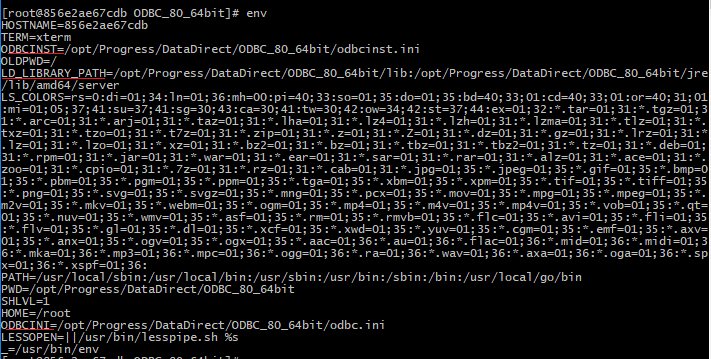Connect to Oracle, Salesforce and others using ODBC from Golang on Linux
Introduction
If you are looking to connect to your databases like SQL Server, Oracle, DB2, Postgres, MongoDB etc., or SaaS apps like Salesforce, Eloqua, Oracle Sales Cloud, Oracle Service Cloud etc., using a ODBC driver from your Go application, this is the place to get started. In this tutorial, we will walk you through on how you can connect to Oracle database from Go using Progress DataDirect ODBC drivers on a Linux machine.
Pre-requisites
Have GO installed on your machine.
Download and Install DataDirect Oracle ODBC driver
- Go to our website and download the 64-bit ODBC driver for the Oracle database for Linux.
- Extract the contents of the package by running this command
tar -xvzf PROGRESS_DATADIRECT_ODBC_ORACLE_LINUX_64.tgz
- Now run the below command to install the Progress DataDirect ODBC driver
./PROGRESS_DATADIRECT_ODBC_8.0_LINUX_64_INSTALL.bin -i console
- Go through the installation and stick to default options. You should be done with it few minutes.
- After the installation has completed, edit .bashrc and add the following lines to add necessary environment variables
LD_LIBRARY_PATH=/opt/Progress/DataDirect/ODBC_80_64bit/lib:/opt/Progress/DataDirect/ODBC_80_64bit/jre/lib/amd64/serverexport LD_LIBRARY_PATHODBCINI=/opt/Progress/DataDirect/ODBC_80_64bit/odbc.iniexport ODBCINIODBCINST=/opt/Progress/DataDirect/ODBC_80_64bit/odbcinst.iniexport ODBCINST
Note: If you changed the install path during the installation, please provide the corresponding path for above configuration files.
- Save the .bashrc and exit. Now run the below command to execute .bashrc to add the environment variables for all your sessions.
source .bashrc - Verify if all the three environment variables are present by running the below command
envConfigure ODBC DSN for Oracle Connection
- Go to the path /opt/Progress/DataDirect/ODBC_80_64bit/ and edit odbc.ini as shown below.
[ODBC]IANAAppCodePage=4InstallDir=/opt/Progress/DataDirect/ODBC_80_64bitTrace=0TraceFile=odbctrace.outTraceDll=/opt/Progress/DataDirect/ODBC_80_64bit/lib/ddtrc28.so[Oracle]Description=DataDirect 8.0 Oracle Wire ProtocolDriver=/opt/Progress/DataDirect/ODBC_80_64bit/lib/ddora28.soAccountingInfo=Action=AlternateServers=ApplicationName=ApplicationUsingThreads=1ArraySize=60000AuthenticationMethod=1CachedCursorLimit=32CachedDescriptionLimit=0CatalogIncludesSynonyms=1CatalogOptions=0ClientHostName=ClientID=ClientUser=ConnectionRetryCount=0ConnectionRetryDelay=3CryptoProtocolVersion=TLSv1.2,TLSv1.1,TLSv1CryptoLibName=DataIntegrityLevel=1DataIntegrityTypes=SHA1,MD5DefaultLongDataBuffLen=1024DescribeAtPrepare=0EditionName=EnableScrollableCursors=1EnableServerResultCache=0EnableDescribeParam=0EnableStaticCursorsForLongData=0EncryptionLevel=1EncryptionMethod=0EncryptionTypes=FailoverGranularity=0FailoverMode=0FailoverPreconnect=0FetchTSWTZasTimestamp=0GSSClient=nativeHostName=<Hostname>HostNameInCertificate=IANAAppCodePage=4InitializationString=KeyPassword=Keystore=KeystorePassword=LoadBalancing=LobPrefetchSize=4000LocalTimezoneOffset=LockTimeout=-1LogonID=LoginTimeout=15Module=PortNumber=1521PRNGSeedFile=/dev/randomPRNGSeedSource=0ProcedureRetResults=0ProgramID=QueryTimeout=0ReportCodepageConversionErrors=0ReportRecycleBin=0ServerName=ServerType=0ServiceName=SID=xeSSLLibName=SupportBinaryXML=0KeepAlive=0TimestampEscapeMapping=0TNSNamesFile=Truststore=TruststorePassword=UseCurrentSchema=1ValidateServerCertificate=1WireProtocolMode=2
- In the above configuration, the 4 parameters you would need to modify are the DSN Name, HostName, Port Number and SID/Service Name.
- Save the file after you have configured your connection and exit.
Connect to Oracle from Go
- Get ODBC package for Go by running the following command
go get github.com/alexbrainman/odbc
- Following is a sample application on how you can connect to Oracle using Progress DataDirect ODBC driver and query a table. This is just a starter code, you can modify this as per your needs.
package mainimport ( "database/sql" "fmt" _ "github.com/alexbrainman/odbc")func main() { var ( regionID int regionName string ) //Open Connection. Provide DSN, Username and Password db, err := sql.Open("odbc", "DSN=Oracle;Uid=saikrishnabobba;Pwd=<progress>") if err != nil { fmt.Println("Connection Failed :( ", err) } else { fmt.Println("Can Connect :)") } //Provide the Query to execute rows, err := db.Query("select REGION_ID, REGION_NAME from REGIONS") if err != nil { fmt.Println("Unable to Query :( ", err) } //Parse the Resultset defer rows.Close() for rows.Next() { err := rows.Scan(®ionID, ®ionName) if err != nil { fmt.Println("Error when parsing :( ", err) } fmt.Println(regionID, regionName) } err = rows.Err() if err != nil { fmt.Println(err) } //Close the connection defer db.Close()}You can use similar steps with any of DataDirect ODBC suite of drivers available for Relational databases like SQL Server, MySQL, PostgreSQL etc., Big Data sources like Hive, Spark etc., SaaS sources like Salesforce, Eloqua, Oracle Sales Cloud etc., and NoSQL Data sources like MongoDB. Feel free to try any of our drivers with your Go apps for connecting to your datasource of your choice.
